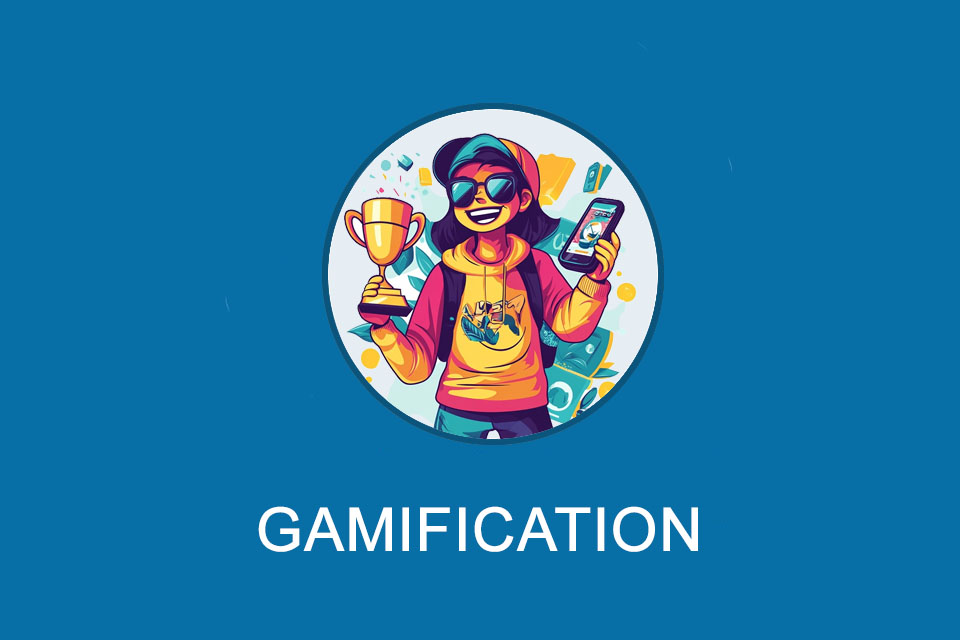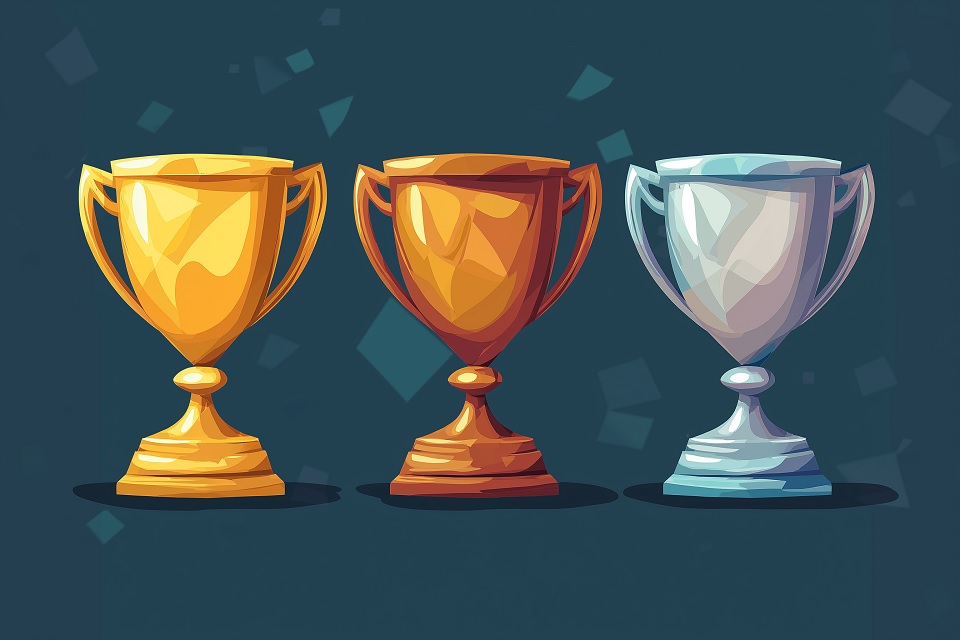What is Gamification?
Table of Contents: Definition – Psychological mechanisms – Areas of application – Opportunities and challenges – Questions from the field – Notes
Gamification – the fun way to success
‘100 points! That’s how many points this picture has earned me. It puts me in 35,327th place in the worldwide ranking! Yes!’
What at first glance sounds like an exclamation from a video game is in fact the reaction of someone who uses a special app to track down and photograph artworks by a French artist in public spaces. Why does he do it? Because he enjoys it. Because it makes him walk through the city with his eyes open and perceive it more intensely. Because it makes him feel like a hunter-gatherer. [1]
And what is behind this motivation? Gamification.
Gamification – sometimes also called gamification, gamification or simply gaming – is the application of game-like elements in a non-game context. These include points, rankings, badges, levels or challenges that are used to influence motivation, engagement and behaviour. [2]
The principle is not new – companies were already experimenting with game-based mechanisms for employee motivation in the 1980s. [3] However, the term ‘gamification’ was coined by Nick Pelling around 2002. Since then, the concept has become established in many areas, from education and marketing to fitness apps and corporate health management.
Gamification uses psychological principles to motivate people. It appeals to our natural urge to play, uses reward systems and often creates a certain competitive situation. Whether in school, at work or in leisure apps – gamification has long since become part of our everyday lives and is changing the way we learn, work and interact.
The psychological mechanisms of gamification
Gamification is so effective because it appeals to deeply rooted psychological principles. It uses mechanisms from motivational and behavioural psychology, cognitive processes and emotional responses to motivate people and positively influence their behaviour:
1. basic human needs
The method’s success is based on the fact that it addresses fundamental human needs. A central need is the desire for social recognition and status. People appreciate it when their achievements are visible and appreciated. Progress in the form of points, badges or rankings gives them the feeling of being part of a larger community and doing better in comparison to others.
The need for competence and mastery also plays an important role. People strive to expand their abilities, overcome challenges and constantly improve. Appropriate levels of difficulty, progress indicators and specifically highlighted successes encourage people to engage more intensively with a task or topic and to keep getting better at it.
Another basic need is autonomy. People want to act and make decisions independently. Options allow users to choose different paths to reach their goal. Whether it’s through alternative game modes, different levels of difficulty or personalised goals, users feel more involved when they can decide for themselves how they want to proceed.
Furthermore, social bonding is an important factor. Humans are social beings and seek interaction with others. Cooperation and competition increase motivation and foster a sense of belonging. Sharing successes, solving tasks together and friendly competition ensure deeper engagement and long-term motivation.
2. motivational psychology
Motivation is the driving force behind human behaviour. It arises both from external incentives and from the intrinsic joy of an activity. External rewards such as points, badges or rankings often provide a quick entry into a gamified environment. However, they can lose their long-term effect if they are not combined with other motivating elements.
Internal motivation, on the other hand, arises when people enjoy a task, see it as a personal challenge or want to develop further. An appealing design, exciting challenges and a pleasant user experience promote this effect. The transition from external to internal motivation is particularly effective: users may start because of the rewards, but stay with it in the long term because they find the activity itself enriching.
A central aspect of motivational psychology is the self-determination theory. It states that people are particularly committed and motivated when three basic psychological needs are met: autonomy, competence and social inclusion. Successful implementation gives people a sense of self-determination, the opportunity to expand their own abilities and a sense of connection to others.
Another important mechanism is the so-called flow state. This describes a state of complete absorption and concentration in which people block out their environment and focus entirely on a task. This is achieved by designing tasks in such a way that they are challenging but not overwhelming. The constant increase in difficulty and the opportunity for continuous improvement ensure that the user remains in the flow and continues to be motivated.
3. behavioural psychology
This method influences behaviour through targeted psychological mechanisms:
- Behaviours that are rewarded occur more frequently. Positive reinforcement in the form of badges, progress indicators or bonuses for regular activity creates a conditioned motivation to devote time to a task again and again.
- Immediate feedback increases the motivation to repeat. When an action immediately triggers a reaction – e.g. through a score display or a visual reward – a reinforcement effect occurs that stabilises the desired behaviour.
- Regular interactions promote new behaviours in the long term. Repeated small rewards and continuous challenges help to ensure that users keep coming back and thus develop a habit.
4. cognitive mechanisms
Gaming elements can facilitate cognitive processes and support learning and decision-making. Cognitive relief plays an important role here. Complex tasks or processes become more understandable through clear structures. Progress displays, visual rewards or step-by-step challenges help to avoid overwhelming users and guide them through the process.
Another effective mechanism is narrative integration. Stories and context-related narratives emotionally engage people and make a task more exciting. When users can identify with a story or feel they are part of a larger narrative, they stay motivated and engaged for longer.
Setting goals is also a crucial factor. People are particularly motivated when they have clear, achievable goals in mind. Interim goals and visible progress help to maintain a sense of achievement and sustain motivation in the long term.
5. emotional aspects
Emotions have a major influence on behaviour and motivation:
- The brain’s reward system is activated when goals are achieved or badges are earned. This leads to the release of dopamine, which increases the desire for further achievements.
- Challenges and game-based elements also make boring or difficult tasks more enjoyable. Positive emotions increase engagement and promote long-term retention of an activity.
- Dealing with setbacks is strengthened when challenges are used in a targeted manner. Those who fail often but keep trying to get better develop a higher tolerance for frustration and thus greater resilience.
Conclusion: the use of gamification elements is so effective because it is based on fundamental psychological principles. It addresses basic human needs, motivates through reward and challenge, and influences behaviour through targeted mechanisms. Cognitive processes are simplified, emotional reactions reinforce long-term bonding. Through the targeted use of these mechanisms, both learning processes and behaviours can be sustainably improved.
Areas of application for gamification
Gamification is no longer a trend, but a proven concept for motivating people and positively influencing behaviour. Whether in education, healthcare or marketing, playful mechanisms such as points, rewards or rankings promote engagement, ambition and long-term loyalty. But what exactly are the areas of application and how do you benefit from gamification?
Education and e-learning: imparting knowledge in a playful way
Why struggle through dry textbooks when learning can also be fun? Learning platforms and apps such as Duolingo, Kahoot! or Quizlet motivate students and adults with levels, badges and rankings. In schools and companies, interactive learning games increase attention and ensure that knowledge is stored sustainably. Especially in digital education, playful challenges are a key to motivation.
Company and workplace: increasing productivity
Boring employee training and monotonous tasks are a thing of the past. Companies are increasingly turning to gamification to boost employee motivation. Interactive training platforms reward completed modules with points or badges. Sales teams compete against each other in sales competitions, and digital feedback systems such as Microsoft Viva or SAP SuccessFactors use gamification to boost employee loyalty. Even applicant management benefits: companies like Google or PwC test applicants with game-based challenges.
Health and fitness: stay active with games
Health trackers and apps like Fitbit, Nike Run Club or MyFitnessPal motivate users to adopt a healthier lifestyle with progress bars, daily targets and virtual rewards. Those who manage 10,000 steps a day receive a badge, and those who exercise regularly move up in the rankings. Gamification is also used in therapy: apps help chronically ill patients to organise their medication in a playful way or support rehabilitation through challenges.
Marketing and customer retention: more than advertising
Brands use gamification to retain customers and increase interaction with their products. Successful models include McDonald’s Monopoly, which attracts millions of customers every year, and Payback, which uses a reward system to boost customer loyalty. Apps like Starbucks Rewards also use gamification mechanisms to influence purchasing behaviour. Companies are also offering interactive campaigns with augmented reality (AR) or collecting competitions to integrate customers more closely into their brand world.
Search engine optimisation (SEO): better placement through gamification
Gamification has also found its way into the digital world. Google and other search engines rate websites according to quality and relevance – a kind of points system for content. The better an article is optimised (e.g. through readability, linking and keyword density), the higher it is listed in the search results. SEO tools such as Yoast SEO or SEMrush also use gamification to show users how they can improve their content to achieve a higher score and thus a better ranking.
Sustainability and environmental protection: making the world a better place through play
Why not make the world a little better with gamification? Initiatives such as Too Good To Go or Ecosia reward sustainable behaviour: users save food or plant trees through search queries. Recycling apps such as recycl.io or Pfandgeben.de use points systems and challenges to motivate people to sort their rubbish. Smart cities are also embracing gamification: cities such as Amsterdam use apps to encourage their citizens to adopt environmentally friendly behaviour, for example by offering rewards for cycling.
Private use: gamification in everyday life
It is not only companies or institutions that benefit from game-based elements – we also encounter gamification in our private lives on a daily basis. Many people use geocaching, a kind of digital treasure hunt with GPS coordinates, to discover the world in a playful way. Families reward their children with points for completing chores, and even dating apps like Tinder use gamification elements: those who are particularly active increase their visibility.
Whether it’s for learning, working, shopping or leisure, gamification is everywhere and makes even everyday tasks more exciting. There are no limits to the imagination!
Opportunities and challenges of gamification
The use of game-based elements has proven to be an effective way to increase motivation, facilitate learning and retain users in the long term in many areas. Whether in education, marketing or business, interactive mechanisms make processes more attractive and efficient. However, in addition to these promising possibilities, there are also challenges that need to be considered during implementation. While creative incentives have the potential to inspire people and encourage positive behaviour, they can also cause frustration or manipulation if not used correctly.
Let’s take a look at the opportunities and advantages:
- Motivation and engagement are increased. Elements such as points, levels or rewards make users feel more involved and stay active for longer.
- Learning and information retention are improved. Playful methods encourage interaction and help to make complex content easier to understand and retain in the long term.
- Customer loyalty is increased. Reward systems such as bonus points or exclusive benefits ensure that consumers interact regularly with a brand or product.
- Healthy or sustainable behaviour is encouraged. Fitness apps or sustainability programmes motivate people to eat more healthily, exercise more or act in a more environmentally conscious way.
- Employee motivation and performance are increased. Companies use interactive approaches to make training more attractive or to increase productivity through competitions.
- Psychological and therapeutic measures benefit from game-based elements. Behavioural changes can be facilitated, e.g. in addiction prevention or in therapy approaches.
However, in addition to the opportunities, there are also some challenges:
- Not every strategy with game-based elements automatically leads to the desired success. In addition to the many advantages, there are also some challenges that must be considered in order to achieve sustainable and positive effects.
- Short-term motivation can prevent long-term benefits. If rewards are not permanently relevant, interest can quickly wane. The challenge is to create sustainable incentives.
- Manipulative mechanisms can lead to overstimulation. Users can be unconsciously enticed into unhealthy behaviour, e.g. excessive use of apps or compulsive collecting of rewards.
- Not everyone benefits equally from these methods. What works for one target group can be completely ineffective for another, which is why targeted adaptation is necessary.
- Frustration or demotivation can be the result. If game mechanics are poorly designed or users feel that they have no realistic chance of success, the effect can be negative.
- High technical and financial resources are often required. Implementation can be costly and technically demanding, especially for small companies or educational institutions.
- Data protection and ethical issues must be taken into account. The collection and use of user data requires transparency and a responsible approach to avoid problems.
Gamification offers many opportunities to motivate people, impart knowledge or influence behaviour. At the same time, challenges such as data protection, sustainable motivation and fair mechanisms must be taken into account. A well-thought-out and responsible approach is certainly the key to long-term success.
Questions from the field
Here are some questions and answers from the field:
What is the connection between gamification and nudging?
Gamification and nudging are both strategies that aim to influence human behaviour – albeit with different approaches and mechanisms. Both concepts use psychological principles to motivate people to take certain actions. They are designed to steer behaviour in a desired direction without exerting force. And both concepts work with positive reinforcement to motivate people. Gamification uses rewards, points or rankings, while nudging works with unconscious incentives such as decision architecture or modified contexts.
| Characteristic | Gamification | Nudging |
| Mechanism | Relies on playful elements such as points, badges, levels or rankings. | Uses subtle changes in the decision-making environment to encourage desired behaviour. |
| User awareness | Users are aware of the game-based incentives and actively participate. | People often do not notice that their behaviour is influenced by a gentle nudge. |
| Example in the health sector | Direct influence through extrinsic motivation (e.g. reward systems). | A canteen places healthy food more prominently than unhealthy food to encourage healthier choices. |
| Intensity of intervention | Direkter Einfluss durch extrinsische Motivation (z. B. Belohnungssysteme). | Indirect influence through contextual change and unconscious behavioural control. |
| Target group | Often suitable for people who want to be actively motivated. | Particularly suitable for situations in which decisions are usually made unconsciously. |
What is the difference between game-based learning and gamification?
In contrast, gamification aims to make existing learning processes more motivating by using game-based incentives. This does not involve developing stand-alone educational games, but rather adding elements such as points, badges, progress bars or rankings to existing systems. One example of this is Duolingo, where users are rewarded for regular practice. Online courses also use progress bars and certificates to motivate participants. The main difference, therefore, lies in the depth of the game-based integration: while game-based learning uses the game itself as the primary learning medium, gamification remains a supplementary element that makes the learning process more attractive.
Both concepts have the common goal of optimising the learning process, but with different focuses. Game-based learning is particularly suitable for context-related, exploratory learning, while gamification is often used in standardised learning environments or to increase long-term motivation. In practice, the two approaches can also be combined, for example, when an educational game also contains progress displays or reward systems to further increase motivation.
| Criterion | Game-Based Learning (GBL) | Gamification |
| Type of integration | Learning takes place directly within a game. | Existing learning processes are enriched with playful elements. |
| learning process | Players acquire knowledge and skills by playing. | Playful mechanics motivate learning, but do not directly influence the learning content. |
| Example | A simulation game on financial management in which players manage a company. | A learning portal that awards progress bars and badges for completed modules. |
| Interactivity | High interaction with the game world, learning through active problem solving. | Interaction often occurs through reward systems or challenges. |
By the way: Serious games and game-based learning (GBL) are not the same, even though they overlap considerably. The main difference lies in the perspective: serious games are a product: they are independent games with an educational or training purpose. Game-based learning is a method: it describes how games (whether serious games or commercial games) are used for learning purposes. Or to put it another way: every serious game can be used in game-based learning, but not every game-based learning requires a serious game.
What is meant by active and passive gamification?
In contrast, passive gamification works more subtly in the background, without users actively ‘playing’. Here, playful elements are used to unconsciously promote motivation and engagement, for example through progress bars, reward systems or personalised recommendations. Users perceive these elements but do not actively interact with them. Both approaches can be combined to motivate users and retain them on a platform or in a system in the long term.
Examples of active gamification:
- Duolingo: Users collect points and unlock levels by actively completing language exercises.
- Kahoot! (educational quiz): Players compete against each other in a quiz and receive points for correct answers.
- Nike Run Club: Users receive badges for achieving running goals.
Examples of passive gamification:
- Netflix & Spotify recommend content based on user behaviour and present these as ‘quests’ (e.g. ‘Because you’ve seen X, you might like Y’).
- Amazon Prime displays ‘achievements’ (e.g. ‘You’ve completed 10 orders this year’).
- LinkedIn progress bar when creating a profile: users feel motivated to complete their profile.
Impulse to discuss:
How much potential remains untapped because we don’t design work, learning or customer interaction in a playful way?
Notes (links partly in German):
If you like the article or would like to discuss it, please feel free to share it in your network. And if you have any comments, please do not hesitate to send us a message.
[1] The app is called Flash Invaders; it allows users to collect points by photographing mosaics that the artist Invader has placed all over the world.
[2] Karl M. Knapp takes a broader view. According to this, gamification encompasses a broad spectrum of approaches – from simple game elements to complex game environments. It uses game mechanics, aesthetics and mindsets to captivate users, motivate them to take action, promote learning processes and facilitate problem solving. See: The Gamification of Learning and Instruction: Game-based Methods and Strategies for Training and Education
[3] As early as 1795, Friedrich Schiller emphasised in his letters On the Aesthetic Education of Man: ‘[…] play is a human activity that alone is capable of bringing forth the totality of human abilities […] Man only plays where he is fully human in the full sense of the word, and he is only fully human where he plays.’ And in Homo Ludens, cultural historian Johan Huizinga wrote in 1938: ‘I do not claim that culture emerges from play, but that it grows in play, and also that in some cases it retains its playful character where one does not expect it or is not aware of it, in short, how often play and seriousness in culture are inseparable or merge into one another.’
And here you will find additional information from our t2informatik Blog:



